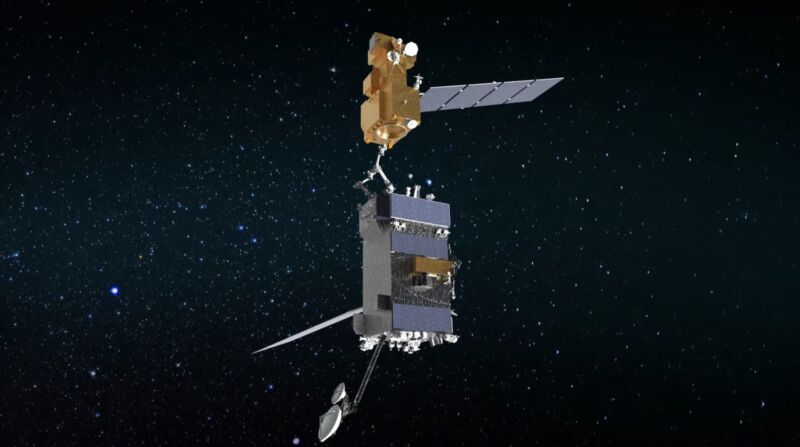
Enlarge / Artist’s illustration of the OSAM-1 spacecraft (bottom) linking up with the Landsat 7 satellite (top) in orbit.
NASA
NASA has canceled an over-budget, behind-schedule mission to demonstrate robotic satellite servicing technology in orbit, pulling the plug on a project that has cost $1.5 billion and probably would have cost nearly $1 billion more to get to the launch pad.
The On-orbit Servicing, Assembly, and Manufacturing 1 mission, known as OSAM-1, would have grappled an aging Landsat satellite in orbit and attempted to refuel it, while also demonstrating how a robotic arm could construct an antenna in space. The spacecraft for the OSAM-1 mission is partially built, but NASA announced Friday that officials decided to cancel the project “following an in-depth, independent project review.”
The space agency cited “continued technical, cost, and schedule challenges” for the decision to cancel OSAM-1.
Mission creep
The mission’s cost has ballooned since NASA officially kicked off the project in 2016. The mission’s original scope called for just the refueling demonstration, but in 2020, officials tacked on the in-orbit assembly objective. This involved adding a complex piece of equipment called the Space Infrastructure Dexterous Robot (SPIDER), essentially a 16-foot-long (5-meter) robotic arm to assemble seven structural elements into a single Ka-band communications antenna.
The addition of SPIDER meant the mission would launch with three robotic arms, including two appendages needed to grab onto the Landsat 7 satellite in orbit for the refueling demonstration. With this change in scope, the name of the mission changed from Restore-L to OSAM-1.
A report by NASA’s inspector general last year outlined the mission’s delays and cost overruns. Since 2016, the space agency has requested $808 million from Congress for Restore-L and OSAM-1. Lawmakers responded by giving NASA nearly $1.5 billion to fund the development of the mission, nearly double what NASA said it wanted.
Restore-L, and then OSAM-1, has always enjoyed support from Congress. The mission was managed by NASA’s Goddard Space Flight Center in Maryland. Former Sen. Barbara Mikulski (D-Maryland) was a key backer of NASA missions run out of Goddard, including the James Webb Space Telescope. She was the top Democrat on the Senate Appropriations Committee when Congress started funding Restore-L in late 2015.
At one time, NASA projected the Restore-L mission would cost between $626 million and $753 million and could be ready for launch in the second half of 2020. That didn’t happen, and the mission continued facing delays and cost increases. The most recent public schedule for OSAM-1 showed a launch date in 2026.
In 2020, after reshaping the Restore-L mission to become OSAM-1, NASA formally laid out a budget for the renamed mission. At the time, NASA said it would cost $1.78 billion to design, build, launch, and operate. An independent review board NASA established last year to examine the OSAM-1 mission estimated the total project could cost as much as $2.35 billion, according to Jimi Russell, a NASA spokesperson.
The realities of the satellite servicing market have also changed since 2016. There are several companies working on commercial satellite servicing technologies, and the satellite industry has shifted away from refueling unprepared spacecraft, as OSAM-1 would have demonstrated with the Landsat 7 Earth-imaging satellite.
Instead, companies are focusing more on extending satellite life in other ways. Northrop Grumman has developed the Mission Extension Vehicle, which can latch onto a satellite and provide maneuvering capability without cutting into the customer spacecraft to refuel it. Other companies are looking at satellites that are designed, from the start, with refueling ports. The US military has a desire to place fuel depots and tankers in orbit to regularly service its satellites, giving them the ability to continually maneuver and burn propellant without worrying about running out of fuel.
Note: This article have been indexed to our site. We do not claim legitimacy, ownership or copyright of any of the content above. To see the article at original source Click Here












